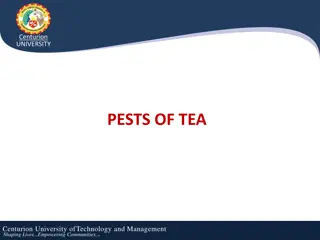Fun with Tea Party Mathematics
Get ready for a delightful tea party as you solve colorful mathematical puzzles involving tea cups! Explore symmetry, patterns, and strategic thinking to arrange the cups in unique ways. Dive into the world of shapes and colors while challenging your problem-solving skills in a fun and engaging tea party setting fit for a celebration!
Download Presentation

Please find below an Image/Link to download the presentation.
The content on the website is provided AS IS for your information and personal use only. It may not be sold, licensed, or shared on other websites without obtaining consent from the author.If you encounter any issues during the download, it is possible that the publisher has removed the file from their server.
You are allowed to download the files provided on this website for personal or commercial use, subject to the condition that they are used lawfully. All files are the property of their respective owners.
The content on the website is provided AS IS for your information and personal use only. It may not be sold, licensed, or shared on other websites without obtaining consent from the author.
E N D
Presentation Transcript
Maths tea party Setting the table for the tea party for a celebration e.g. the coronation of King Charles III
Stay safe Whether you are a scientist researching a new medicine or an engineer solving climate change, safety always comes first. An adult must always be around and supervising when doing this activity. You are responsible for: ensuring that any equipment used for this activity is in good working condition behaving sensibly and following any safety instructions so as not to hurt or injure yourself or others Please note that in the absence of any negligence or other breach of duty by us, this activity is carried out at your own risk. It is important to take extra care at the stages marked with this symbol:
Arrange the teacups in the grid so that there is only one of each colour in each row and column.
What is the same and what is different about these solutions?
What shapes can you see in the way the colours are arranged?
Arrange the teacups in the grid so that there is only one of each colour in each row and column.
What was your strategy? Is your solution the same as your partner s?
What shapes can you see this time?
Why are we having tea with Euler? Born in Switzerland in 1707 Mathematician, physicist, astronomer, geographer, logician and engineer ? (pi*) * Also good at teatime! The Officer Problem
This time there has to be one of each colour and one of each item in every row and column
What is the same and what is different about these solutions? Can you still see the triangles?
Can we use what we have learned to put one of each colour and one of each item into every row and column?
What patterns can you see in this solution?
What patterns can you see in this solution?
Eulers Officer Problem There are 36 officers They are in 6 regiments Each regiment has officers with 6 different ranks or titles* Can they be arranged into a ? ? grid so that there is one from each regiment and one from each rank in each row and column? *like arranging a cup, saucer, plate, knife, fork and spoon in each colour into a ? ? grid
Eulers Officer Problem Spoiler alert! It wasn t possible! Can they be arranged into a ? ? grid so that there is one from each regiment and one from each rank in each row and column? *like arranging a cup, saucer, plate, knife, fork and spoon in each colour into a ? ? grid
Euler said that it wasnt possible to solve this sort of problem for squares where the length of a side followed this pattern: 4 0 + 2 = 2 4 2 + 2 = 10 4 1 + 2 = 6 We can use algebra to explain this pattern: 4? + 2
What happened next? Proof that 10 10is possible. Only 2 2and 6 6don t work Proof that 6 6won t work Euler worked on the problem 1779 1901 1960 It took nearly 120 years to sort out the Officer Problem and another 60 to prove that Euler s rule was incorrect.
Where do you see this sort of pattern? Have you ever done a Sudoku?























